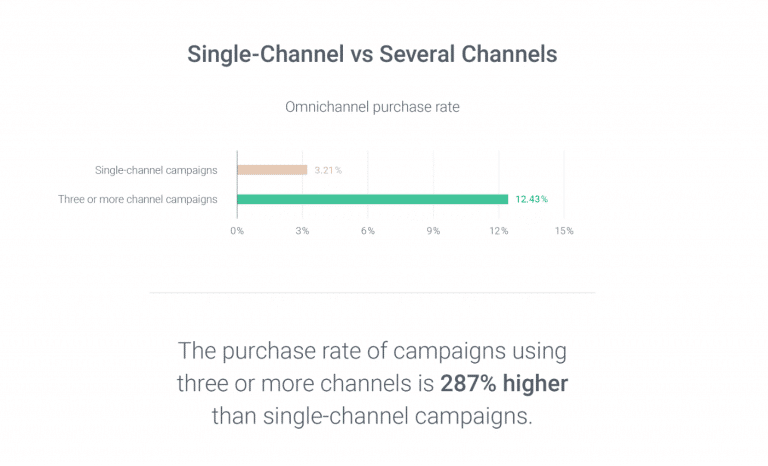Like many businesses, you’re most likely using a multichannel marketing strategy running SEO, PPC, and Social Media campaigns.
But do your campaigns complement each other and your overarching digital goals?
This is where an omnichannel marketing strategy comes into play.
Omnichannel marketing is a seamless digital customer experience regardless of the marketing channel that your customer is on. The intention of this approach is that every touchpoint your customer has with your brand, it feels like a continuation of the previous touchpoint (think about a marketing funnel and what’s next).
This means that the strategy must be deliberately crafted from start to finish with a message that develops at each touchpoint and remains relevant to the stage of the customer journey and ultimately, the customer.
Your SEO campaign and content, your PPC ads, social media ads, and EDMs, need to be crafted in tandem to create a seamless digital marketing strategy that nurtures your customers to purchase or enquire.
While this can sound like a multichannel strategy, it’s not. Plain and simple.
Here’s why.
Omnichannel vs. multichannel strategy
The main point of difference between an omnichannel and multichannel marketing strategy is knowing where your customer is in their marketing journey.
Omnichannel marketing offers a personalised approach that places your customer at the centre of the strategy. The messaging within your strategy changes depending on how your customer engages, and what their needs are.
Every message across channels is created with specific intent and to serve based on previous interactions.
The better targeted messaging to their specific stage of the journey, the more likely your customers are to interact.
Customer centric approach
In a multichannel marketing approach, a business will be looking to cast a wide net and get in front of as many relevant eyeballs as possible. This will often be the case running, Google Ads, Facebook Ads, LinkedIn Ads, as well as running an SEO campaign. However, there will be no cohesion between these channels.
Whereas an omnichannel marketing strategy will intertwine each channel to engage customers holistically. This methodology is focused on creating a strong relationship with the customers and doesn’t simply target a large impression share.
Consistent messaging
A consistent message in your omnichannel strategy is necessary to deliver a high level customer experience. Businesses running an omnichannel strategy must be diligent to ensure their customers are receiving the same experience across all channels and through each interaction.
If there are several internal departments or marketers working on an omnichannel marketing strategy, you need to ensure that they are all aligned and delivering the same message and brand image. If they are not in-tune, the likelihood of a successful strategy will significantly decrease.
Buyer effort levels
Another key component is the level of effort the customer needs as part of the journey. The intention of the omnichannel approach is to create a seamless experience. We want the customer to feel like their engagements do not create additional effort for them to do so.
A high level of data analysis and strategy implementation is required to ensure that every step is effortless for the customer. The less effort from customers, the more effective our strategy, leading to increased sales.
Who is an omnichannel marketing strategy for?
Is an omnichannel Marketing Strategy appropriate for every business? Absolutely not.
It’s crucial to identify how your audience behaves and whether the customer experience is a key factor in their decision-making process. This will help determine the right marketing strategy for your business.
Businesses that need to grab the customers attention, provide a high level of customer experience, and may also have a longer buying journey where customers need to be nurtured, are better candidates.
It’s also essential that you have the right tools, strategy, and process in place to be able to deliver an omnichannel approach.
What are the benefits of an omnichannel marketing strategy?
1. The advantage of customer data
Often businesses have customer data in excess and haven’t taken it to their advantage. For many marketers, this data is like finding gold. Utilising this data is what takes a good strategy and makes it great.
Here are a few questions you can ask yourself:
- What experience are my customers having?
- What is my customer purchase process?
- What channels are my customers using to find my business?
- What channels are my customers using to buy my products/services?
- What experience are my customers having post sale?
- How many of my customers are becoming repeat business?
- Have we surveyed our customers for feedback?
Once you’ve gone through this process and answered all of these queries, you will be equipped with insights on where to improve your customer experience as well as what areas the business needs to improve. Ideally, you will also be able to gain a better appreciation for how to utilise your data at each step of your customers’ purchase process.
The next step as part of your omnichannel strategy will be utilising this data to craft highly targeted messaging. These messages will be specific to where your customers are in the buyer’s journey and tailored to their preferences.
As part of your strategy, this data will also allow you to create automations to better reach out to your customers at the right time, with the right message, effortlessly.
2. Improve your personalisation with targeted messages
We just spoke about better targeted messaging. Now to unpack this further.
Personalisation is the heartbeat of an omnichannel marketing strategy. How we utilise the data to create hyper-targeted messages is the core of a successful strategy.
Segmentation is the next step to create personalised messages within your strategy. Segmenting your audiences into different interest groups will help you better create tailored messaging appropriate for their stage of the journey. The intention is to create a message which will provoke a desired action.
As an example, you can identify customers who haven’t made a purchase within the last 30 days. Now you can create a relevant message appropriate to their stage of the buyer’s journey and reach out to them with a promotional offer. Then using the data that you have collated about this type of customer; you can reach out on the platform that will yield the best return and will likely lead to a purchase.
3. Increased purchase rates
Utilising data, segmentation, and personalisation, the experience your customers will be having will be far greater than if you were running a Single Channel campaign. This greater experience directly correlates to an increase in purchases.
In 2020, marketing campaigns that utilised several channels vs. those that only ran one, lead to a 287% increase in purchases.

https://www.omnisend.com/blog/wp-content/uploads/2020/10/Single_vs_Several_channels.png
4. Increased average order
Not only are customers more likely to order from an omnichannel campaign, on average, they are likely to spend more per order.
Recently, statistics have shown that omnichannel marketing campaigns yield a 13% increase in average spending per order.
5. Increased customer loyalty & retention rates
It can cost up to five times more to attract a new customer than it does to retain an existing one.
Also, according to a study done by Frederick Reichheld from Bain & Company; increasing customer retention rates by 5%, can result in profit increases of between 25% – 95%.
Now to relate this back. Comparing a single channel to an omnichannel marketing strategy, in 2020, customer retention rates were 90% higher when an omnichannel campaign was implemented.
Combining increased purchase rates, increased average order, and increased retention rates, an omnichannel approach effectively sells itself.
Conclusion
Utilising an omnichannel marketing strategy will allow you to provide more value to your customers and an exceptional & seamless customer experience. With the right business, and implemented correctly, the increase in sales, average order spends, brand awareness, and retention rates can lead to hugely positive results on business growth.
If you’re trying to decide whether an omnichannel marketing approach is right for your business, feel free to reach out to the team at Distl.






